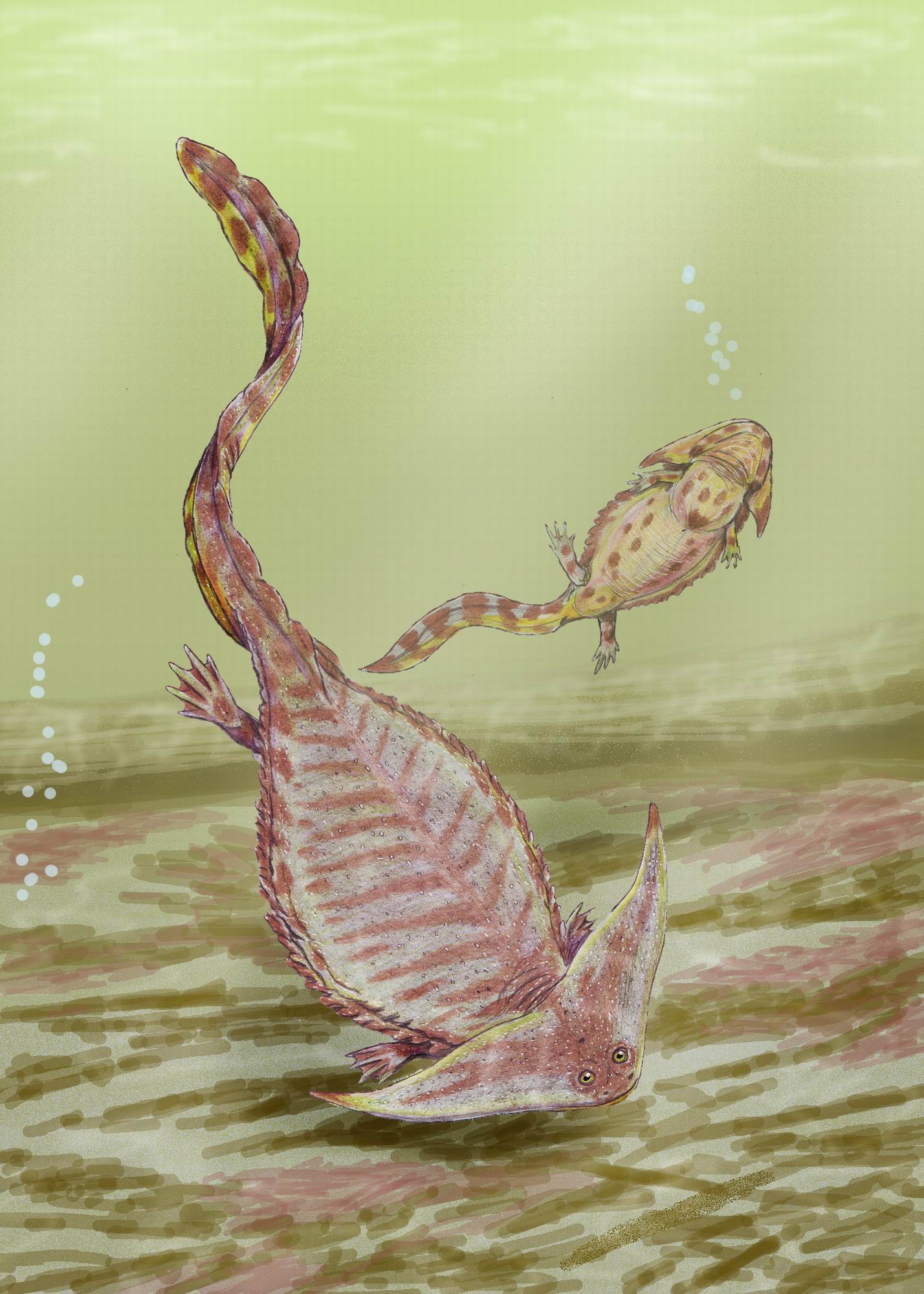- Lepospondyli
Taxobox
name = Lepospondyls
fossil_range =Carboniferous -Permian

image_width = 150px
image_caption = "Diplocaulus "
regnum =Animal ia
phylum =Chordata
subphylum =Vertebrata
superclassis =Tetrapoda
classis = Amphibia
subclassis = Lepospondyli
subclassis_authority = Zittel,1888
subdivision_ranks = Groups
subdivision = See textLepospondyli are a group of small but diverse
Carboniferous to earlyPermian amphibian s. Six differentclade s are known, the Acherontiscidae,Adelospondyli ,Aïstopoda ,Lysorophia ,Microsauria andNectridea , and between them they include newt-like, eel- or snake-like, and lizard-like forms, along with species that don't fit any current category. Various species were aquatic, semi-aquatic, or terrestrial. None were large (the biggest genus, the keraterpetontid "Diplocaulus ", reached a meter in length, but most were much smaller), and it can be assumed that they lived in specialised ecological niches not taken by their more numerous Temnospondyl contemporaries.Classification
All Lepospondyls are most notably characterised by having simple, spool-shaped vertebra, which were not preformed as
cartilage but rather grew as bony cylinders around thenotochord . Usually also the upper portion of the vertebra, the neural arch, is fused to the centra (the main body of the vertebra) (Colbert 1969).No clear common ancestors are known, since each of the known clades are already highly specialised when they first appear in the fossil record. It is not known whether the Lepospondyls are an artificial (
polyphyletic ) group which independently evolved similar characteristics of the vertebra, or whether they descended from a singlecommon ancestor .At one time it was thought that some Lepospondyls are related or perhaps ancestral to modern
Urodela , although this view is no longer held. For a long time they were considered one of the three subclasses ofamphibian s (Romer 1966, Colbert 1969, Carroll 1988) More recently it has been suggested that the Lepospondyls may be related or ancestral to modern amphibians as well as toamniotes (reptiles etc) (Laurin 1996) , that they are an artificial grouping with some members related to both extinct and living amphibians (Batrachomorpha ) but not amniotes (Benton 2000), or alternatively are a monophyletic group closely related to the ancestry of amniotes but not to recent amphibians (Benton 2004).Apart from the Nectridea, Lepospondyls are limited in distribution to Europe and North America (Carroll 1988).
Taxonomy
Class
Amphibia
* Subclass LEPOSPONDYLI
** OrderAdelospondyli
** Family Acherontiscidae
** OrderAïstopoda
*** Family Lethiscidae
*** Family Ophiderpetontidae
*** FamilyOestocephalidae
*** Family Pseudophlegethontiidae
*** FamilyPhlegethontiidae
** OrderNectridea
*** "Arizonerpeton "
*** FamilyScincosauridae
*** FamilyKeraterpetontidae
*** FamilyUrocordylidae
** SuperorderMicrosauria
*** Family Odonterpentontidae
***Tuditanomorpha
**** FamilyPantylidae
**** FamilyTuditanidae
**** FamilyHapsidopareiontidae
**** FamilyGymnarthridae
**** FamilyOstodolepididae
**** Family Trihecatontidae
**** Family Goniorhynchidae
*** FamilyBrachystelechidae
*** OrderLysorophia
**** FamilyLysorophidae References
* Benton, M. J. (2000), "Vertebrate Paleontology", 2nd ed. Blackwell Science Ltd
* Benton, M. J. (2004), "Vertebrate Paleontology", 3rd ed. Blackwell Science Ltd [http://palaeo.gly.bris.ac.uk/benton/vertclass.html Taxonomic hierarchy]
* Carroll, RL (1988), "Vertebrate Paleontology and Evolution", WH Freeman & Co.
* Colbert, E H. (1969), "Evolution of the Vertebrates", John Wiley & Sons Inc (2nd ed.)
* Laurin, Michel (1996) [http://tolweb.org/tree?group=Terrestrial_Vertebrates&contgroup=Sarcopterygii Terrestrial Vertebrates - Stegocephalians: Tetrapods and other digit-bearing vertebrates]
* Romer, A.S., (1966) "Vertebrate Paleontology" University of Chicago Press, 1933; 3rd ed. 1966.See also
*
Animal
*Amphibian
*Prehistoric amphibian
*Prehistoric life External links
* [http://www.erin.utoronto.ca/~w3bio356/lectures/lepo_liss.html Biology 356 - Major Features of Vertebrate Evolution: Lepospondyls and Lissamphibians] by Dr. Robert Reisz
* [http://www.palaeos.com/Vertebrates/Units/Unit170/170.000.html Lepospondyli - Palaeos]
* [http://www.permiantetrapods.net/LEPOSPONDYLI.html Lepospondyli]
* [http://www.fmnh.helsinki.fi/users/haaramo/Metazoa/Deuterostoma/Chordata/Amphibia/Lepospondyli/Lepospondyli.htm Lepospondyli - phylogeny]
Wikimedia Foundation. 2010.
